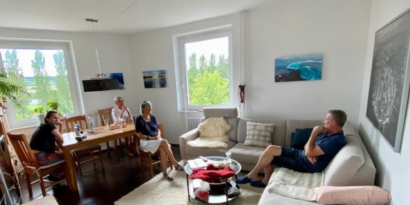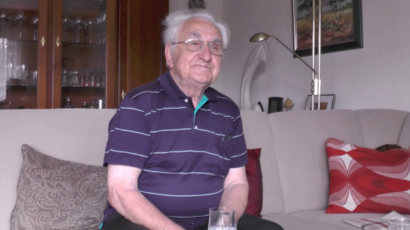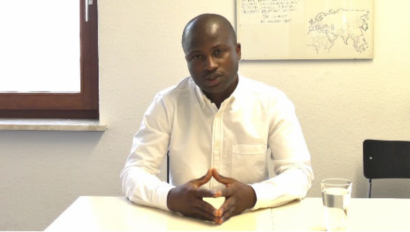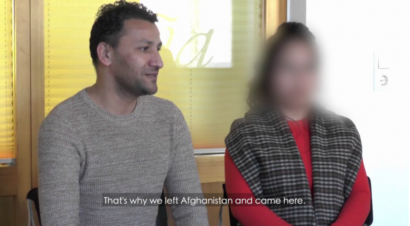PRACTICE | IMPLEMENTATION | POTENTIAL | TOOLS | READING LIST
Biographical interviews can be open or closed. There are different forms of interview technique. One important distinction is how the interview is conducted. One or more persons can talk uninterruptedly, i.e. monologically (open), or the interviewer can interrupt by asking follow-up questions (closed). What all forms have in common is that every interview is a process of interaction between the narrator(s) and the interviewer.
THE DIFFERENT FORMS OF INTERVIEW TECHNIQUE ARE:
1. The narrative interview
Opens with an introductory question that corresponds with the topic. This stimulates the interviewee’s willingness to talk. Only narration, no evaluation or argumentation is allowed. In contrast to other interview techniques, the narrative interview does not serve the purpose of confirming opinions or hypotheses.
2. The guided interview
Is a way of obtaining detailed information on a specific topic. The interviewee can give concrete information and the interviewer can ask follow-up questions and questions of understanding. In this sense, this interview technique is similar to an ordinary conversation.
3. The biographical interview
The structure of a biographical interview follows the temporal traces of an entire life story.
“Oral history is the recording of people’s memories.
It is the living history of everyone’s unique life experiences”.
PRACTICE
How to conduct a biographical interview
Before and during the interviews, the following must be observed:
- Check and ensure the technical conditions and the functioning of the equipment.
- Ensure that the atmosphere is calm and free of disturbances.
- Explain to the interviewees that selected passages will be translated into English and video clips will be published on the project’s website as learning examples and obtain their written consent.
- Preface the interview with a brief summary of the topic.
- Clarify the time frame.
- Do not interrupt the flow of speech, accept pauses in the narrative.
After the interview:
- If necessary, have an after-interview discussion with the interviewees to enable them to process, balance and evaluate their own experiences.
- Show the complete interviews and the clips to the interviewees.
Implementation in the project
Experiences in the project
 The people interviewed have different cultural, religious, social and political backgrounds and different reasons of their flight. The interviews enable a transnational narrative and thus an expansion of historical perspectives beyond national and state borders. They are the basis for a video documentation, an exhibition and a theatre production. All four interviews have a duration of about one hour and were conducted in German.
The people interviewed have different cultural, religious, social and political backgrounds and different reasons of their flight. The interviews enable a transnational narrative and thus an expansion of historical perspectives beyond national and state borders. They are the basis for a video documentation, an exhibition and a theatre production. All four interviews have a duration of about one hour and were conducted in German.
Clips were cut from these long interviews, lasting no more than 10 minutes and focusing on the theme of “flight and expulsion”.
The first interview with H.C., a 90-year-old German who fled with his family from East Prussia to the West in 1945, was conducted as a narrative interview.
As for the interviews with A.A. from Togo, Mr. and Mrs. A. from Afghanistan and with S.P. from Bosnia, the method of a guided interview was used. All interviewees have in common that their German language level is B1. This method made it possible to obtain detailed information on the topic without overburdening the interviewees linguistically.



Potential of the method for transnational and multi-perspective approaches
It was found that all interviewees lost their own sense of time during the interview and the interviewer had to signal the end. The telling of one’s own story to interested persons was responded to with much openness and attention to detail. The experience that one’s personal story is significant triggered a lot of empathy towards people who have to leave their homes for all kinds of reasons at all times.
Tools / Downloads
Preparatory hints for conducting a biographical interview
Preparatory hints for recording a biographical interview
Reading list
Gabriele Rosenthal: Erlebte und erzählte Lebensgeschichte. Gestalt und Struktur biografischer Selbstbeschreibungen. Campus, Frankfurt a. M./New York 1995.
Gisela Jakob: Das narrative Interview in der Biografieforschung. In: Barbara Friebertshäuser, Annedore Prengel (Hrsg.): Handbuch Qualitative Forschungsmethoden in der Erziehungswissenschaft. Juventa, Weinheim/München 1997, S. 445 – 458.
Ivonne Küsters: Narrative Interviews. Grundlagen und Anwendungen. Lehrbuch, Wiesbaden 2006.
